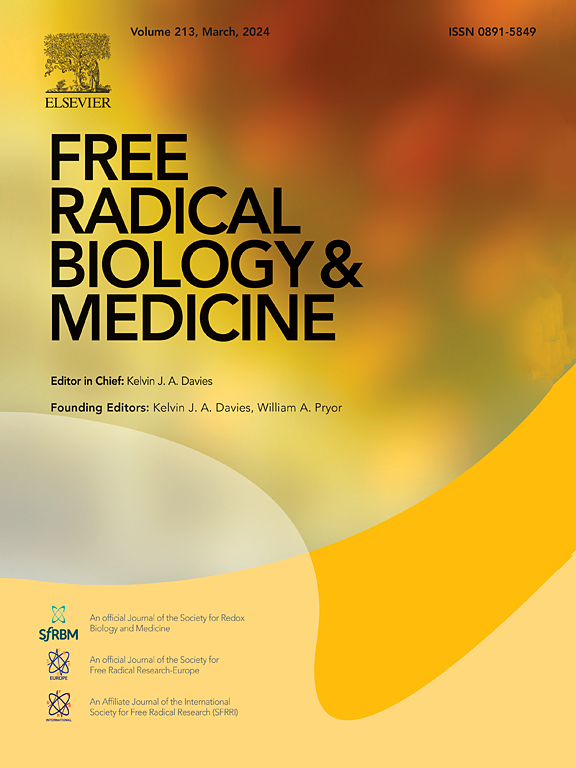Experiences of multiple psychosocial stressors and associations with oxidative stress biomarkers during pregnancy
IF 7.1
2区 生物学
Q1 BIOCHEMISTRY & MOLECULAR BIOLOGY
引用次数: 0
Abstract
Background
Oxidative stress is hypothesized to be one mechanism linking psychosocial stressor exposure to preterm birth and other adverse pregnancy outcomes. However, prior studies have focused solely on singular psychosocial stressors, which may not reflect real world exposures as pregnant women may experience multiple stressors simultaneously.
Methods
Participants included a subset of the Chemicals in Our Bodies cohort, a prospective birth cohort in San Francisco, California (N = 227). Self -reported psychosocial stressors were assessed via questionnaires administered during the second trimester that addressed financial strain, food insecurity, job strain, neighborhood quality, caregiving, stressful life events, unplanned pregnancy, and perceived community status. Oxidative stress biomarkers were measured during the second trimester of pregnancy and included 15-F2t-IsoP, and its two major metabolites 2,3-dinor-5,6-dihydro-15-F2t-IsoP, and 2,3-dinor-15-F2t-IsoP, and PGF2α. Linear regression models were used to examine associations between individual and pairwise combinations of psychosocial stressors in relation to each oxidative stress biomarker.
Results
15-F2t-IsoP, 2,3-dinor-15-F2t-IsoP, and 2,3-dinor-5,6-dihydro-15-F2t-IsoP were elevated among participants reporting experiences of low perceived community status, job strain, poor neighborhood quality, food insecurity, and stressful life events (e.g., β = 0.36, 95 % CI = 0.00, 0.72 for food insecurity in association with 15-F2t-IsoP). In models that included pairwise combinations of stressor exposures, nearly every combination was also associated with an increase in all oxidative stress biomarkers compared to those who experienced one or neither stressor. For example, stressful life events and poor neighborhood quality was associated with statistically significant increases in all biomarkers (e.g., β = 0.94, 95 % CI = 0.17, 1.71 for 2,3-dinor-5,6-dihydro-15-F2t-IsoP).
Conclusions
Urinary oxidative stress biomarkers were elevated among pregnant women exposed to psychosocial stressors, and exposure to multiple stressors resulted in the strongest associations. These findings support oxidative stress as one potential biological pathway linking prenatal psychosocial stress to preterm birth and other adverse pregnancy outcomes.

妊娠期间多种社会心理应激源的经历及其与氧化应激生物标志物的关联
背景氧化应激被假设为一种机制,将社会心理应激暴露与早产和其他不良妊娠结局联系起来。然而,先前的研究只关注单一的社会心理压力源,这可能不能反映真实世界的暴露,因为孕妇可能同时经历多种压力源。方法参与者包括我们体内化学物质队列的一个子集,这是一个来自加州旧金山的前瞻性出生队列(N = 227)。自我报告的社会心理压力源通过在妊娠中期进行的问卷调查进行评估,问卷涉及经济压力、食物不安全、工作压力、社区质量、护理、压力生活事件、意外怀孕和感知的社区地位。在妊娠中期测量氧化应激生物标志物,包括15-F2t-IsoP及其两种主要代谢物2,3-二氢-5,6-二氢-15-F2t-IsoP, 2,3-二氢-15-F2t-IsoP和PGF2α。线性回归模型用于检验个体和两两组合的社会心理应激源与每个氧化应激生物标志物之间的关联。结果15-F2t-IsoP、2,3-dinor-15-F2t-IsoP和2,3-dinor-5,6-二氢-15-F2t-IsoP在报告低感知社区地位、工作压力、社区质量差、食物不安全和压力生活事件的参与者中升高(例如,β = 0.36, 95% CI = 0.00, 0.72)食物不安全与15-F2t-IsoP相关。在包括压力源两两组合的模型中,与那些经历过一种或两种压力源的人相比,几乎每一种组合都与所有氧化应激生物标志物的增加有关。例如,有压力的生活事件和较差的社区质量与所有生物标志物的统计学显著增加相关(例如,β = 0.94, 95% CI = 0.17, 2,3-二氢-5,6-二氢-15- f2t - isop)。结论暴露于社会心理应激源的孕妇血清氧化应激生物标志物升高,且多重应激源的相关性最强。这些发现支持氧化应激是一种潜在的生物学途径,将产前心理社会压力与早产和其他不良妊娠结局联系起来。
本文章由计算机程序翻译,如有差异,请以英文原文为准。
求助全文
约1分钟内获得全文
求助全文
来源期刊

Free Radical Biology and Medicine
医学-内分泌学与代谢
CiteScore
14.00
自引率
4.10%
发文量
850
审稿时长
22 days
期刊介绍:
Free Radical Biology and Medicine is a leading journal in the field of redox biology, which is the study of the role of reactive oxygen species (ROS) and other oxidizing agents in biological systems. The journal serves as a premier forum for publishing innovative and groundbreaking research that explores the redox biology of health and disease, covering a wide range of topics and disciplines. Free Radical Biology and Medicine also commissions Special Issues that highlight recent advances in both basic and clinical research, with a particular emphasis on the mechanisms underlying altered metabolism and redox signaling. These Special Issues aim to provide a focused platform for the latest research in the field, fostering collaboration and knowledge exchange among researchers and clinicians.
 求助内容:
求助内容: 应助结果提醒方式:
应助结果提醒方式:


